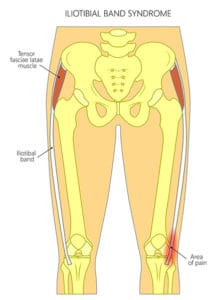 Iliotibial Band Syndrome: Common Running Injuries
Iliotibial Band Syndrome: Common Running Injuries
Iliotibial Band Syndrome, also known as IT Band Syndrome, is a common running injury. It’s an overuse injury that can affect both new runners and seasoned runners. Since that’s the case, runners of all levels need to understand what causes IT Band Syndrome, how to prevent it, and how to treat it if you do get it.
What is Iliotibial Band Syndrome?
IT Band Syndrome is an inflamed or overly tight Iliotibial (IT) band caused by overuse. The IT band is a connective tissue group that runs from the outside of the hip, along the thigh, to the tibia (shin bone). It crosses over the hip joint and the knee joint to provide stabilization and support knee movement.
When the knee bends, the IT band crosses over the knee joint. Typically, the IT band gently glides over the knee joint with no problems. After too much friction, though, the IT band can start to get irritated and swollen. If it is swollen, the IT band will stop gliding smoothly over the knee joint. It can start to catch on the joint a little bit, and it will start to feel like a small crack or snap when the knee bends. IT Band Syndrome is painful, especially while running.
Symptoms
The primary symptom of IT Band Syndrome in runners is pain along the outside of the knee. Pain occurs when the inflamed IT band crosses over the knee joint, which tends to happen right after the heel strikes the ground.
Symptoms of IT Band Syndrome pain include:
- Pain on the outside of the knee, above the joint, while running.
- Aching or burning pain on the outside of the knee
- The outside of the knee is tender to touch.
- Feeling a click or pop along the outside of the knee while running.
- Pain radiating along the outside of the leg
Mild symptoms can typically be treated on your own. If the symptoms worsen, however, you should see a doctor for medical attention.
Causes
Iliotibial Band Syndrome occurs the most when the leg turns inward a little too much while running. It is a common running injury that can stem from a few problems. Most often, it is caused by improper training techniques, poor running form, or physiological problems.
Training and running form problems:
- Running downhill too much
- Running in the same direction on a curved track repeatedly.
- Running on a banked surface repeatedly.
- Running too far too frequently.
- Not stretching before and after runs.
- Not warming up before runs or cooling down after runs.
- Rotating the leg, knee, or ankle inward while running
- Using old, worn-out running shoes
Physiological problems:
- Being bow legged
- Having weak muscles surrounding the knee and hip
- Having one leg that’s longer than the other
- Having arthritis in the knee
How can I prevent IT Band Syndrome?
Though many physiological problems that cause Iliotibial Band Syndrome can’t be fixed without medical intervention, some can. Almost all of the problems caused by improper training or running form can be corrected.
- Make sure that you are using quality running shoes that fit your foot and stride.
- Run on flat surfaces whenever possible.
- If you are running on a track with repeated curves, run it in both directions.
- Stretch thoroughly before and after runs to increase flexibility.
- Warm-up before runs and cool down after runs.
- Gradually increase your mileage rather than suddenly increasing it.
- Cross-train to strengthen the muscles around your knee and hip joints.
If you would like to improve your running form, consider hiring a running coach. Running coaches can help you with personal training that can improve your form to reduce your injury chance.
How to treat Iliotibial Band Syndrome?
If you notice symptoms of IT Band Syndrome, take them seriously. Symptoms can be treated pretty quickly when they are mild, but they can get much worse if left untreated.
To treat Iliotibial Band Syndrome:
Rest, ice, and treat the pain. While IT Band Syndrome is still mild, take it easy and take care of your knee. Ideally, stop running for a few days while you rest your leg. Ice your knee up to 3 times each day for 15-20 minutes at a time. Take NSAIDs (Non-Steroidal Anti-Inflammatory Drugs) as needed.
Stretch and foam roll. Start doing stretches that increase flexibility around the knee and hip joints. You can also use a foam roller along the outside of your leg from the shin to the hip to help loosen your IT band.
Get medical help. Visit a qualified massage therapist or physical therapist for treatment. They will be able to massage the area to improve mobility and provide advice to treat your specific symptoms.
Read our other articles written on Common Running Injuries.
A Training Plan that Works for You.
Our collection of running plans will help you train year-round. From 5k to a 100-mile ultramarathon, we have a training plan built for your experience level and goals. Every plan is delivered via Final Surge, allowing you to sync workouts across devices, receive daily reminders of workouts and activities, and analyze workout and target zone details. Get started today with a training plan built for you, view our running plans here.










